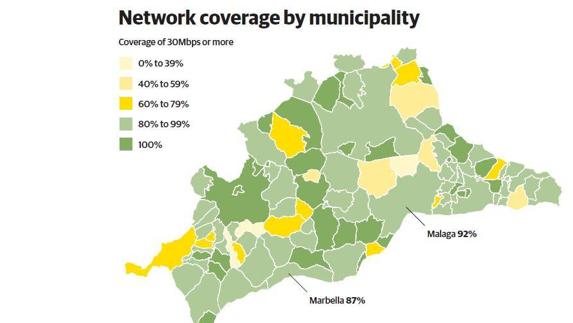

Sections
Highlight

IGNACIO LILLO
Monday, 27 July 2020, 12:42
Compartir
Broadband internet is essential for remote working, studying at home, online shopping and digital leisure, but not everywhere in Malaga province has the same access to it.
Officially, 84 municipalities have what is known as FTTH (Fibre To The Home) which means that only 19 are yet to be connected. In reality, however, there are regular complaints from mayors, residents and business owners about the level of cover (where broadband is available, over 70 per cent of the population on average can access it, and nearly 30 per cent can't), and there are continual breaks in connection. The lack of quality internet is considered a key factor in the loss of population from rural villages, and it also limits the possibilities of tempting new residents to move from towns to villages.
The Secretary of State for Telecommunications and Digital Infrastructures (part of the Ministry of Economic Affairs and Digital Transformation) and Telefónica, the biggest operator in the market in Spain, provide the data on internet access. According to these sources, the province isn't doing badly compared with other parts of Spain.
Telefónica is carrying out a plan to install fibre optic in every municipality in Andalucía by 2024. In Malaga province, including the Costa del Sol, nearly 82 per cent now have it, and by the end of this year another eight places will benefit from it as well, raising the coverage to 90 per cent.
The average percentage of access in these places is over 70 per cent (in other words it has been installed but not every home has access to it and schools, town halls etc. have priority). In many places access is over 80 per cent, or even up to 90 per cent. More than 465,000 properties (homes and businesses) in Malaga province have FTTH cover now, according to Telefónica. Alfarnate is the latest village to have been connected.
On the other hand, there is still a lack of this service in some places and even in Malaga city itself, districts such as Campanillas are experiencing connection problems. This is paradoxical, bearing in mind that the PTA Technology Park is located right beside it.
In the Axarquía, Cútar is one of the villages still without a fibre optic internet connection, while others such as Salares are confident that they will be connected soon.
"Telefónica told us before the pandemic that it planned to install fibre optic here this year," said the mayor, Pablo Crespillo.
Fibre optic has been installed in Sayalonga, although many homes in the village still don't have access to it. In Comares, on the other hand, the mayor, Manuel Robles, said they are now waiting for 5G. Local companies such as Axartel have announced plans to reach places such as Benamargosa and are already offering it in Benamocarra and Vélez-Málaga.
In the Serranía de Ronda, most municipalities now benefit from fibre optic, some of them only recently. However, there is a general feeling of dissatisfaction with its effectiveness, and mayors are reporting constant problems.
"How are we going to attract tourists if we can't offer them a good quality internet connection?" said Pedro Godino, mayor of Gaucín. Auxiliadora Sánchez, mayor of Atajate, said the system there has not been working properly for weeks.
In other parts of the province in places with the biggest populations, broadband coverage is good in the centre, but the speed reduces in outlying districts. Installation is ongoing in parts of the Guadalhorce Valley, such as Casarabonela; and in some places in the Antequera and Guadalteba areas.
Rural repopulating
Pelle Lundborg is an example of the potential of rural municipalities to attract new residents and talent. This 42-year-old Swedish businessman works with new technology and video games and recently became involved in ecological agriculture and tourism, after buying a property in Casarabonela.
This is one of the villages which does not yet have fibre optic and he has to work via a satellite connection, with a capacity of 20 Mbps, which he says is hard.
"If you want to attract foreigners and business, then fibre optic is essential," he said.
He learned from his native Sweden that a powerful Internet network is vital for the economic development of rural areas. Like him, other professionals are keen to move inland, thanks to the increased popularity of working from home. "But one of the first things people ask is whether there is fibre. It is not the whole answer to rural depopulation, but it is very important," he said.
Juan Luis Cruz, the head of the College of Telecommunication Technical Engineers, advises the Malaga provincial government, which has a specific department to tackle depopulation.
"In many villages there is not total fibre optic coverage, so thousands of residents are in a difficult situation technologically speaking and the situation is not equal to that in cities."
He believes this is a key factor in preventing depopulation and encouraging development.
"If I want to open a small hotel, I need high-speed internet to operate my business. The pipes for the fibre should be installed whenever development projects are being carried out, and that is something that the mayors should organise," he said.
Natacha Rivas is the fourth vice-president of the Malaga provincial government, and runs the Public Service and Depopulation department: "One of our objectives is for every village to be connected, so we have set up a technological committee to oversee that," she said. "The Covid crisis has highlighted which rural areas are lacking in this sense," she explained.
Agustín Peláez, Vanessa Melgar and Andrea Jiménez contributed to this article.
Publicidad
Publicidad
Publicidad
Publicidad
Reporta un error en esta noticia
Necesitas ser suscriptor para poder votar.